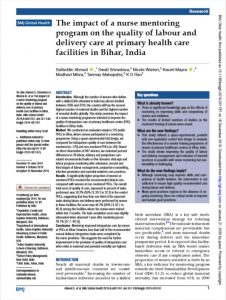
Introduction
Although the number of women who deliver with a skilled birth attendant in India has almost doubled between 2006 and 2016, the country still has the second highest number of maternal deaths and the highest number of neonatal deaths globally. This study examines the impact of a nurse mentoring programme intended to improve the quality of intrapartum care at primary healthcare centre (PHC) facilities in Bihar, India.
Method
We conducted an evaluation study in 319 public PHCs in Bihar, where nurses participated in a mentoring programme. Using a quasi-experimental trial design, we compared the intrapartum quality of care between the mentored (n=179) and non-mentored PHCs (n=80). Based on direct observation of 847 women, we examined percent differences in 39 labour, delivery and postpartum care-related recommended tasks on five domains: vital sign and labour progress monitoring after admission, second and third stages of labour management, postpartum counselling, infection prevention and essential newborn care practices.
Results
A significantly higher proportion of women at mentored PHCs received the recommended clinical care, compared with women at non-mentored PHCs. The overall total score of quality of care, expressed in percent of tasks performed, was 30.2% (95% CI: 28.3 to 32.2) in the control PHCs, suggesting that less than one-third of the expected tasks during labour and delivery were performed by nurses in these facilities; the score was 44.2% (95% CI: 42.1 to 46.4) among the facilities where the nurses were trained within last 3 months. The task completion score was slightly attenuated when observed 1 year after mentoring (score 39.1% [37.7–40.5]).
Conclusion
Mentoring improved intrapartum care by nurses at PHCs in Bihar. However, less than half of the recommended normal delivery intrapartum tasks were completed by the nurse providers. This suggests the need for further improvement in the provision of quality of intrapartum care when risks to maternal and perinatal mortality are highest.